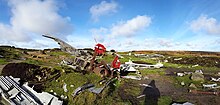
The Enola Gay is a Boeing B-29 Superfortress bomber, named after Enola Gay Tibbets, the mother of the pilot, Colonel Paul Tibbets. On 6 August 1945, during the final stages of World War II, it became the first aircraft to drop an atomic bomb in warfare. The bomb, code-named "Little Boy", was targeted at the city of Hiroshima, Japan, and destroyed about three-quarters of the city. Enola Gay participated in the second nuclear attack as the weather reconnaissance aircraft for the primary target of Kokura. Clouds and drifting smoke resulted in Nagasaki, a secondary target, being bombed instead.

The Boeing RC-135 is a family of large reconnaissance aircraft built by Boeing and modified by a number of companies, including General Dynamics, Lockheed, LTV, E-Systems, L3Harris Technologies, and used by the United States Air Force and Royal Air Force to support theater and national level intelligence consumers with near real-time on-scene collection, analysis and dissemination capabilities.

The Boeing B-29 Superfortress was an American four-engined propeller-driven heavy bomber, designed by Boeing and flown primarily by the United States during World War II and the Korean War. Named in allusion to its predecessor, the Boeing B-17 Flying Fortress, the Superfortress was designed for high-altitude strategic bombing, but also excelled in low-altitude night incendiary bombing, and in dropping naval mines to blockade Japan. B-29s dropped the atomic bombs on Hiroshima and Nagasaki, the only aircraft ever to drop nuclear weapons in combat.

The Boeing B-50 Superfortress is an American strategic bomber. A post–World War II revision of the Boeing B-29 Superfortress, it was fitted with more powerful Pratt & Whitney R-4360 radial engines, stronger structure, a taller tail fin, and other improvements. It was the last piston-engined bomber built by Boeing for the United States Air Force, and was refined into Boeing's final such design, the prototype B-54. Although not as well known as its direct predecessor, the B-50 was in USAF service for nearly 20 years.

Bleaklow is a high, largely peat-covered, gritstone moorland in the Derbyshire High Peak near the town of Glossop. It is north of Kinder Scout, across the Snake Pass (A57), and south of the A628 Woodhead Pass. Much of it is nearly 2,000 feet (610 m) above sea level and the shallow bowl of Swains Greave on its eastern side is the source of the River Derwent.

The Boeing B-29 Superfortress is a United States Army Air Forces long range, strategic heavy bomber that was produced in many experimental and production models from 1943 to 1946.

The Kee Bird was a United States Army Air Forces Boeing B-29 Superfortress, serial 45-21768, of the 46th Reconnaissance Squadron, that became marooned after making an emergency landing in northwest Greenland during a secret Cold War spying mission on 21 February 1947. While the entire crew was safely evacuated after spending three days in the isolated Arctic tundra, the aircraft itself was left at the landing site. It lay there undisturbed until 1994, when a privately funded mission was launched to repair and return it. During the attempted recovery, a fire broke out, resulting in the destruction and loss of the airframe on the ground.

On 3 April 1996, a United States Air Force Boeing CT-43A crashed on approach to Dubrovnik, Croatia, while on an official trade mission. The aircraft, a Boeing 737-200 originally built as T-43A navigational trainer and later converted into a CT-43A executive transport aircraft, was carrying United States Secretary of Commerce Ron Brown and 34 other people, including corporate CEOs. While attempting an instrument approach to Dubrovnik Airport, the airplane crashed into a mountainside. An Air Force technical sergeant, Shelly Kelly, was the stewardess and the only passenger who survived the initial impact; she died en route to a hospital.

The 91st Cyberspace Operations Squadron is an active United States Air Force unit, currently assigned to the 67th Cyberspace Wing at Kelly Annex, part of Lackland Air Force Base, Texas.

Stob na Boine Druim-fhinn is a mountain on the Cowal peninsula in Argyll, Scotland, northwest of Lochgoilhead.
This is a partial list of accidents and incidents involving the Boeing-designed B-17 Flying Fortress. Combat losses are not included except for a very few cases denoted by singular circumstances. A few documented drone attrition cases are also included.
RAF Harpur Hill is a former Royal Air Force station, situated at Harpur Hill near Buxton, Derbyshire in England. The site was operational from 1938 to 1960 and was mainly used as an underground munitions storage facility. It became the largest ammunitions dump in the country across the 500 acres (200 ha) site.

Northeast of San Francisco, California, on 5 August 1950, a United States Air Force Boeing B-29 Superfortress bomber carrying a Mark 4 nuclear bomb crashed shortly after takeoff from Fairfield-Suisun Air Force Base with 20 men on board. Twelve men were killed in the crash, including the commander of the 9th Bombardment Wing, Brigadier General Robert F. Travis, and another seven were killed on the ground when the aircraft exploded. The base was later renamed for Travis.

The Peak District Mountain Rescue Organisation (PDMRO) is a UK registered charity which was formed in 1964. The purpose of PDMRO is "to save life and alleviate distress, primarily in Upland and Mountain areas". This is achieved by conducting search and rescue missions for walkers, climbers and missing persons in and around the Peak District National Park.

The Buxton Mountain Rescue Team is a UK registered charity operating search and rescue missions from its base at Dove Holes near Buxton in Derbyshire. The team covers an area of about 400 square miles across Derbyshire, Staffordshire and Cheshire.
















